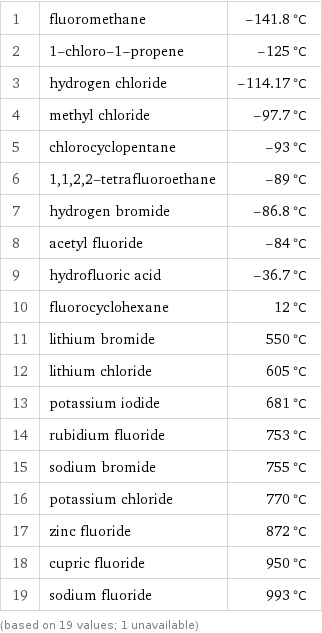Input interpretation

halogenated compounds | freezing point
Summary

median | 12 °C highest | 993 °C (sodium fluoride) lowest | -141.8 °C (fluoromethane) distribution | | (based on 19 values; 1 unavailable)
Entity with missing value

iodoacetonitrile
Distribution plots

(freezing point in degrees Celsius)
Freezing point rankings

1 | fluoromethane | -141.8 °C 2 | 1-chloro-1-propene | -125 °C 3 | hydrogen chloride | -114.17 °C 4 | methyl chloride | -97.7 °C 5 | chlorocyclopentane | -93 °C 6 | 1, 1, 2, 2-tetrafluoroethane | -89 °C 7 | hydrogen bromide | -86.8 °C 8 | acetyl fluoride | -84 °C 9 | hydrofluoric acid | -36.7 °C 10 | fluorocyclohexane | 12 °C 11 | lithium bromide | 550 °C 12 | lithium chloride | 605 °C 13 | potassium iodide | 681 °C 14 | rubidium fluoride | 753 °C 15 | sodium bromide | 755 °C 16 | potassium chloride | 770 °C 17 | zinc fluoride | 872 °C 18 | cupric fluoride | 950 °C 19 | sodium fluoride | 993 °C (based on 19 values; 1 unavailable)
Unit conversions for median freezing point 12 °C

286 K (kelvins)

55 °F (degrees Fahrenheit)

514 °R (degrees Rankine)

10 °Ré (degrees Réaumur)

14 °Rø (degrees Rømer)
Comparison for median freezing point 12 °C

3 °C below temperature at STP (standard temperature and pressure), using the US customary convention (60 °F)

2 °C below temperature at STP (standard temperature and pressure), using the convention of European and South American natural gas companies (15 °C)

1 °C below average surface temperature of the earth (14 °C)
Corresponding quantities

Thermodynamic energy E from E = kT: | 25 meV (millielectronvolts)

Blackbody energy flux Φ from Φ = σT^4: | 378 W/m^2 (watts per square meter)

Approximate luminous exitance from a planar blackbody radiator perpendicular to its surface: | 7×10^-23 lx (lux)